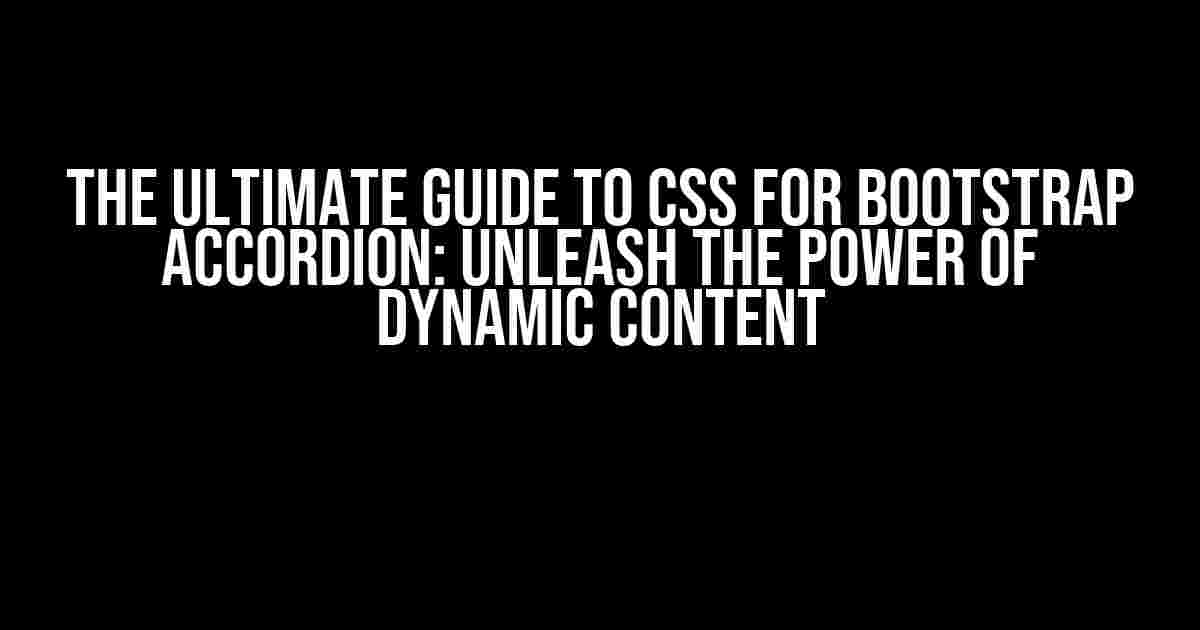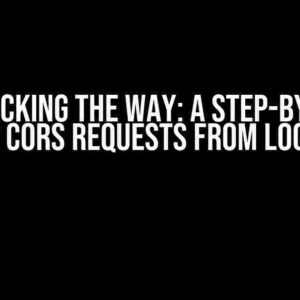Are you tired of cluttered interfaces and tedious scrolling? Do you want to take your website’s user experience to the next level? Look no further! In this comprehensive guide, we’ll dive into the world of CSS for Bootstrap accordion, and show you how to create stunning, interactive content that will leave your users begging for more.
What is Bootstrap Accordion?
Before we dive into the nitty-gritty of CSS for Bootstrap accordion, let’s take a step back and understand what it is. Bootstrap accordion is a popular UI component that allows you to hide and show content dynamically, using a simple click or hover action. This versatile component is ideal for presenting complex information in a concise and organized manner, making it a staple in modern web design.
Benefits of Using Bootstrap Accordion
- Improved User Experience**: Bootstrap accordion helps to reduce clutter and make your content more digestible, leading to a better overall user experience.
- Increased Engagement**: By providing users with a sense of control over the content they see, Bootstrap accordion can increase engagement and encourage users to explore more.
- Enhanced Accessibility**: Accordion components can be used to conceal secondary information, making it easier for users with disabilities to navigate your website.
CSS Basics for Bootstrap Accordion
Before we dive into the advanced CSS techniques, let’s cover the basics. Bootstrap accordion relies on a combination of HTML, CSS, and JavaScript to function. Here’s a breakdown of the basic HTML structure:
<div id="accordion">
<div class="card">
<div class="card-header">
<h5><a data-toggle="collapse" href="#collapseOne">Accordion Item 1</a></h5>
</div>
<div id="collapseOne" class="collapse show">
<div class="card-body">
Accordion content goes here...
</div>
</div>
</div>
</div>
To style the accordion component, we’ll use the following basic CSS selectors:
.accordion {
/* styles for the accordion container */
}
.accordion .card {
/* styles for individual accordion items */
}
.accordion .card-header {
/* styles for the accordion header */
}
.accordion .collapse {
/* styles for the collapsed content */
}
.accordion .card-body {
/* styles for the accordion content */
}
Customizing the Accordion Header
The accordion header is the most critical element of the component, as it provides the user with a clear indication of what’s inside. Let’s customize it using CSS:
.accordion .card-header {
background-color: #f7f7f7;
padding: 10px;
border-bottom: 1px solid #ddd;
cursor: pointer;
}
.accordion .card-header h5 {
margin: 0;
font-weight: bold;
text-transform: uppercase;
}
.accordion .card-header a {
text-decoration: none;
color: #337ab7;
}
.accordion .card-header a:hover {
color: #23527c;
}
Advanced CSS Techniques for Bootstrap Accordion
Now that we’ve covered the basics, let’s dive into some advanced CSS techniques to take your Bootstrap accordion to the next level.
Animating the Accordion Transition
By default, Bootstrap accordion transitions are instantaneous. Let’s add some flair with CSS animations:
.accordion .collapse {
transition: height 0.3s ease-in-out;
}
.accordion .collapse.show {
height: auto;
}
.accordion .collapse:not(.show) {
height: 0;
overflow: hidden;
}
Creating a Custom Accordion Icon
By default, Bootstrap accordion uses a simple caret icon to indicate the collapsible state. Let’s create a custom icon using CSS:
.accordion .card-header a::after {
content: '\f107';
font-family: 'Font Awesome 5 Free';
font-weight: 900;
font-size: 16px;
color: #337ab7;
padding-left: 5px;
}
.accordion .card-header a.collapsed::after {
content: '\f105';
}
Responsive Accordion Breakpoints
To ensure our accordion component looks great on all devices, let’s add some responsive breakpoints using CSS media queries:
@media (max-width: 768px) {
.accordion .card {
margin-bottom: 20px;
}
}
@media (max-width: 480px) {
.accordion .card-header {
font-size: 14px;
}
}
Best Practices for Bootstrap Accordion
When using Bootstrap accordion, keep the following best practices in mind:
- Keep it Simple**: Avoid overloading the accordion with too much content or complex layouts.
- Use it Judiciously**: Only use the accordion when necessary, as it can lead to cognitive overload if overused.
- Test Thoroughly**: Ensure the accordion component works correctly across different browsers, devices, and screen sizes.
- Follow Accessibility Guidelines**: Ensure the accordion content is accessible to users with disabilities by following accessibility guidelines.
Conclusion
In this comprehensive guide, we’ve covered the basics of CSS for Bootstrap accordion, as well as some advanced techniques to take your component to the next level. By following these guidelines and best practices, you’ll be able to create stunning, interactive content that will engage and delight your users.
| Description | |
|---|---|
| .accordion | Container element for the accordion component |
| .card | Individual accordion item element |
| .card-header | Accordion header element |
| .collapse | Collapsed content element |
| .card-body | Accordion content element |
Remember, the key to creating a successful Bootstrap accordion lies in balancing complexity with simplicity, and functionality with aesthetics. By following this guide, you’ll be well on your way to creating stunning, interactive content that will leave your users begging for more.
Further Reading
Frequently Asked Question
Get ahead of the curve with Bootstrap accordions and CSS. Here are some frequently asked questions to help you master the art of collapsing and expanding content like a pro!
How do I style a Bootstrap accordion with CSS?
You can style a Bootstrap accordion with CSS by targeting the accordion’s class, `.accordion`, and its child elements, such as `.accordion-header` and `.accordion-body`. You can also use CSS pseudo-classes like `:hover` and `:focus` to create interactive effects.
How do I change the accordion’s background color?
You can change the accordion’s background color by adding a custom CSS rule, for example: `.accordion { background-color: #f2f2f2; }`. You can also use Bootstrap’s utility classes, such as `.bg-light` or `.bg-dark`, to quickly change the background color.
How do I add a icon to the accordion header?
You can add an icon to the accordion header by adding an HTML element, such as a `` or ``, inside the `.accordion-header` element. You can then style the icon using CSS, for example: `.accordion-header i { font-size: 18px; color: #666; }`.
How do I make the accordion collapsible on hover?
You can make the accordion collapsible on hover by adding a custom CSS rule, for example: `.accordion-header:hover { cursor: pointer; }` and `.accordion-body { display: none; } .accordion-header:hover + .accordion-body { display: block; }`. This will show the accordion body on hover.
How do I animate the accordion’s collapse and expand effects?
You can animate the accordion’s collapse and expand effects using CSS transitions and animations. For example, you can add a transition effect to the `.accordion-body` element, like this: `.accordion-body { transition: height 0.5s ease-in-out; }`. You can then add animation keyframes to create a smooth collapse and expand effect.



